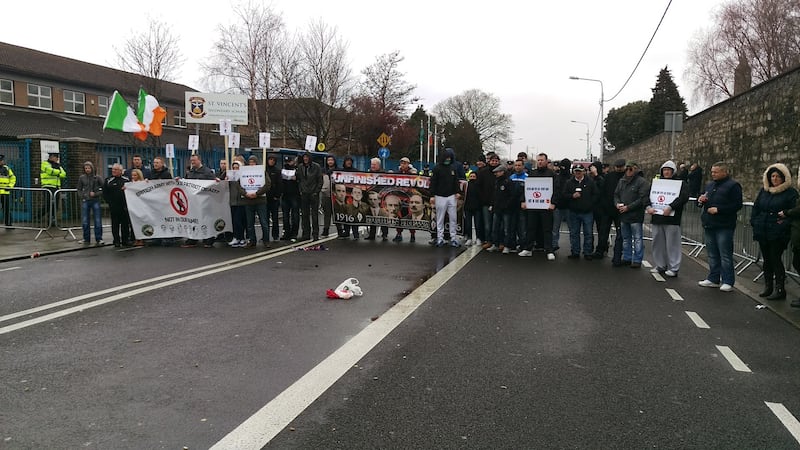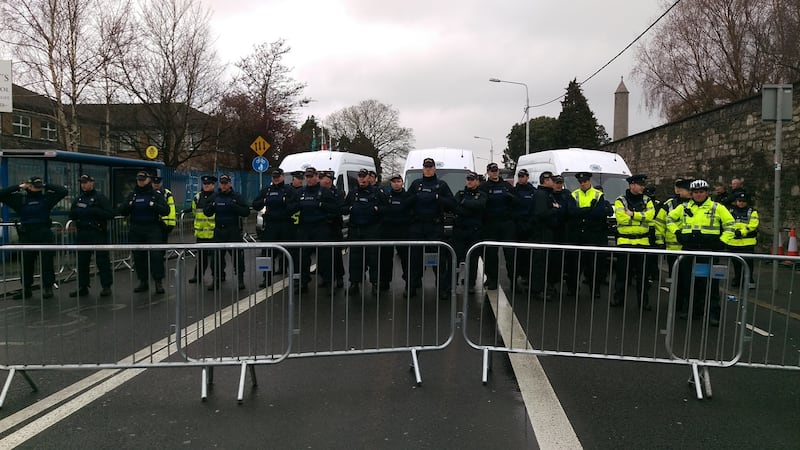Gardaí arrested one person after scuffles broke out between protestors and the Public Order Unit outside Dublin's Glasnevin Cemetery.
Efforts were made to burn a Union Jack and bangers were exploded, one of which was thrown at lines of gardaí and led to the brief altercation.
A number of smoke bombs were also lit and thrown along the ground towards the lines of gardaí. But while efforts were made to set alight the Union Jack and to destroy it with bangers, the flag was too wet to catch fire.


Instead, it was discarded on the road and was walked on and kicked around for a period.
While the unveiling ceremony was taking place, one protestor played Irish rebel songs into a megaphone, apparently in the hope that those at the service some distance away would hear it.
The bangers that exploded could be heard inside, according to some of those present. But Garda sources said the disturbance was minor, adding protestor numbers were much smaller than expected.
The brief clashes between gardaí and protestors occurred outside St Vincent’s Secondary School on Finglas Road, which was blocked to traffic at two points about 400 metres north and south of the main entrance to the cemetery.
Gardaí were keen to keep any protestors far from dignitaries going to and from the event.
A group of about 100 people, mostly men, gathered to protest at the unveiling ceremony in the cemetery of a 'Remembrance Wall' listing the names of all those who died in the 1916 Easter Rising, including British soldiers.
Many of those present carried banners and placards bearing the logo of the 32 County Sovereignty Movement.
One of them read: “British soldiers with our patriot dead? Not in my name.”
Senior Garda officers were charged with avoiding any repeat of scenes in recent years when the President Mr Higgins and Tánaiste Joan Burton were subjected to very robust protests in separate, anti water charges, demonstrations.
During Sunday’s incident, Public Order Unit (riot squad) gardaí emerged from a number of vehicles when the exploding missile was thrown at their uniformed colleagues as they stood facing the protestors with a line of crowd control barriers between them.
A number of gardaí went behind the barriers and into the protest group, grabbing two men before placing them into Garda vans nearby. One was arrested, while the other was removed from the scene.
The protestors jeered while scuffling with the gardaí, though the barriers were reinstated immediately the suspects had been taken away and order was restored.
There then followed a peaceful standoff for about one hour. The protestors on one side of the barriers sealing off the road and the group of uniformed a public order gardai on the other stood watching each other.
At around noon, and with the event in the cemetery concluding, the protestors began to disperse.
Most of the gardaí present, of which there were about 70, also withdrew, though the road remained closed and a smaller Garda presence was maintained for a short time.
The 32 County Sovereignty Movement, whose members were prominent among the protest group, is linked to the Real IRA.
It has in the past included images of Alan Ryan, a key member of the Dublin Real IRA murdered 3½ years ago, in its banners protesting against what it sees as oppression, such as the jailing of dissident republican prisoners.


